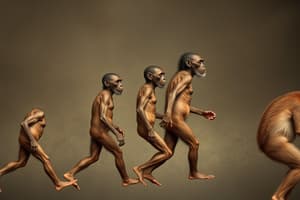Podcast
Questions and Answers
What distinctive feature do all primates possess that facilitates grasping and manipulation of objects?
What distinctive feature do all primates possess that facilitates grasping and manipulation of objects?
- Opposable thumbs (correct)
- Rotatable forearm
- Big brains
- Stereoscopic vision
Which characteristic differentiates early hominids from chimpanzees?
Which characteristic differentiates early hominids from chimpanzees?
- Reduced digits on hands
- Larger brain size (correct)
- Tail presence
- Increased jaw size
What significant evolutionary change occurred approximately 7 million years ago?
What significant evolutionary change occurred approximately 7 million years ago?
- Fire was first controlled by hominids
- Common ancestor of modern primates evolved
- First tool usage began
- Humans diverged from chimpanzees (correct)
What is one disadvantage of bipedalism experienced by early hominids?
What is one disadvantage of bipedalism experienced by early hominids?
What was the significance of fire usage in relation to brain size evolution?
What was the significance of fire usage in relation to brain size evolution?
Which of the following is NOT a characteristic of modern primates?
Which of the following is NOT a characteristic of modern primates?
What evolutionary advantage did the development of tool-making provide to early hominids?
What evolutionary advantage did the development of tool-making provide to early hominids?
Why was the skeletal structure of early hominids adapted for bipedalism?
Why was the skeletal structure of early hominids adapted for bipedalism?
Flashcards
Primate Evolution
Primate Evolution
Primates, including humans, have evolved from a common ancestor over millions of years.
Bipedalism (Walking Upright)
Bipedalism (Walking Upright)
Walking on two legs, a key feature in human evolution, offering advantages like freeing hands.
Early Hominid Characteristics
Early Hominid Characteristics
Early human-like ancestors had smaller jaws, larger brains, and less prominent brow ridges compared to apes.
Australopithecus
Australopithecus
Signup and view all the flashcards
Lucy's Significance
Lucy's Significance
Signup and view all the flashcards
Fire Use in Human Evolution
Fire Use in Human Evolution
Signup and view all the flashcards
Tool Making and Brain Size
Tool Making and Brain Size
Signup and view all the flashcards
Human-Chimpanzee Split
Human-Chimpanzee Split
Signup and view all the flashcards
Study Notes
Primate Evolution
- Primates are mammals, including monkeys, apes, and humans.
- Oldest primate fossils date back 65 million years, following the extinction of dinosaurs.
- Key primate characteristics:
- Opposable thumbs for grasping.
- Relatively large brains (e.g., chimpanzee brain size ~300cc).
- Omnivorous diet.
- Stereoscopic vision and color vision for enhanced survival.
- Rotatable forearms, single births, no tail (in humans).
- Humans and chimpanzees shared a last common ancestor approximately 7 million years ago.
Early Hominids
- Hominids are human-like animals that walked upright.
- Early hominids lived in humid forests of East and Southern Africa, transitioning to grasslands due to climate change.
- Hominid adaptations compared to chimpanzees:
- Smaller jawbones.
- Larger brain sizes.
- Reduced brow ridges.
- Smaller teeth.
- Australopithecus (Southern Ape) was the first primate to habitually walk on two legs, differing in walking mechanics from later hominids.
- Sexual dimorphism (males larger than females).
- Lucy (40% complete skeleton, East Africa, ~3.2 million years ago; 107cm tall) is a notable example.
- Tool use emerged approximately 2-3 million years ago, coinciding with a growth in brain size.
Walking Upright
- Walking upright (bipedalism) in early hominids offered advantages like freeing hands for tasks like carrying objects or infants.
- However, bipedalism presented challenges, requiring adaptations in the skeletal system.
- A change in the location and shape of the skull, upper body, spine, hips, knees, and ankles.
Fire's Impact
- Fire use by hominids provided significant survival advantages:
- Easier digestion of cooked food, potentially boosting brain development.
- Illumination in low-light conditions.
- Defense against predators.
- Increased hunting efficiency in dark environments.
- Maintaining body temperature. -Cooking meat provided easier digestion - increased nutrients led to larger brain sizes.
Tool Use and Cave Paintings
- Toolmaking developed, marking advancements in cognitive abilities.
- Cave paintings indicated further complexity in human societies and symbolic thought.
Agriculture
- The Younger Dryas event (a period of global cooling) led to the development of agriculture, providing a stable food supply, enabling human population growth.
- Agriculture marked a significant shift in human societies and led to lasting improvements in human survival.
Current Human Population
- The current global human population is approximately 8 billion.
Studying That Suits You
Use AI to generate personalized quizzes and flashcards to suit your learning preferences.




